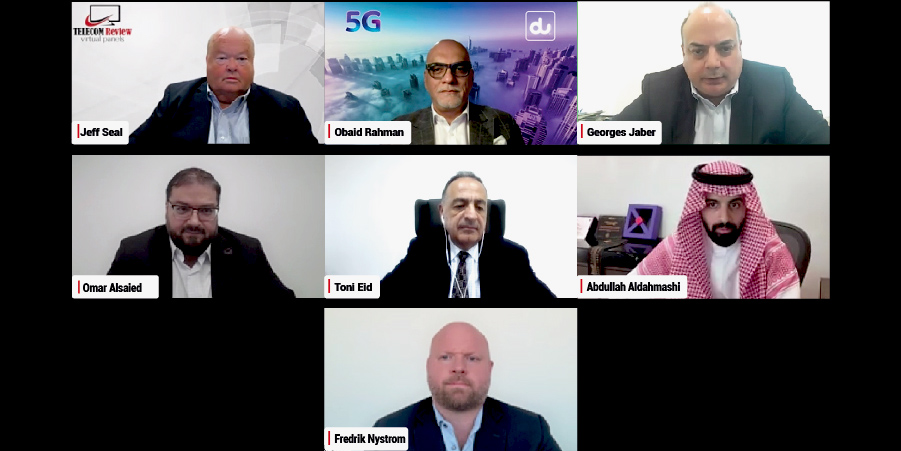Telecom Review has successfully concluded its latest webinar entitled, “The Modern Connectivity Ride,” which dived into a detailed overview of the wholesale services regional landscape.
Toni Eid, CEO of Trace Media and Founder of Telecom Review Group, kicked off the session with a welcome note addressing the audience and panelists. He briefly invited all participants to attend the 18th edition of the Telecom Review Leaders’ Summit, the most-awaited VIP ICT gathering in the industry, set to occur on December 10-11, 2024 in Dubai, UAE.
Jeff Seal, Editor in Chief and Managing Partner for Telecom Review Americas moderated the session, which consisted of the following speakers:
- Abdullah Aldahmashi, Customer Delivery General Manager, center3
- Obaid Rahman, Head of International Wholesale, du
- Omar Alsaied, GM, Wholesale Business Development, Mobily
- Georges Jaber, VP, Wholesales & BD, Salam
- Fredrik Nyström, Director Corporate Development, Zain Omantel International
Current Developments in the Wholesale Industry
“If you look at it from a macro perspective, there's a lot of digitalization happening across all economies. All nations are very laser-focused on digitalization, which is the key ingredient for economic growth,” stated Rahman.
He quoted a statistic to illustrate: Each time there's a 10% increase in broadband penetration, that equates to a growth of 1% in a particular country’s GDP.
Within the Middle East, there is an immense focus on cloudification, be it from an enterprise or consumer perspective. Aligned with this, Rahman pointed out that customers, hyperscalers, large enterprises, content providers, and governments, are “all heterogeneous in terms of the nature of business, but in terms of their wholesale or connectivity requirements, they are becoming very homogeneous.”
There is an overall demand for low latency, high bandwidth, optimized cost, scalability, resilience, redundancy, and diversity.
“There's a lot of dynamicism coming in terms of how we, as wholesalers, serve the industry going forward… There's a seismic shift happening in terms of how we've been traditionally serving our customers and our partners, and how it's moving forward,” the du Executive explained.
Despite being based in the UAE, du is a regional player that has built a big ecosystem. This includes operating datamena, which is the largest ecosystem of hosting partners in that part of the world and the UAE-IX, which is the region's largest internet exchange. du currently boasts 11 data center facilities, with near-term plans to expand by five more.
du also has access to its own organic subsea cables, and is focusing on “capillarity,” meaning they want to bring in more products and services “within the region rather than beyond” it. Rahman further added that ethernet/ IP transit is proving to be a mature line of focus.
In the Kingdom of Saudi Arabia’s arena, Jaber noted that more presence from hyperscalers and OTT providers is needed, consequently, large data center infrastructure is required. “They do it there, on their own, or they buy it from a big data center provider here in the Kingdom,” explained Jaber.
Jaber mentioned that Salam has recently launched several new products and services, including its wholesale voice offering in Saudi Arabia, which focuses on wholesale hubbing, transit, and the termination of voice traffic. As an MVNO, Salam has also introduced an A2P SMS business and is working on establishing new border links with Kuwait and Oman. Additionally, the company is leveraging AI, GPUs, and gigabit connectivity to enhance data dissemination and voice services, bypassing the Red Sea and Gulf regions to reach Jordan and Iraq.
Beyond the traditional focus on augmenting connectivity, Alsaied highlighted the growing importance of software in the Middle East, especially to support hyperscalers and content providers. He emphasized that future differentiation in the industry will come from a powerful software layer, with most new services being driven by advanced software capabilities, data center internet exchanges, and industry orchestration that offers greater flexibility across the region.
“We want to make it easier for international customers to come and do business in Saudi Arabia and in the region,” Alsaied emphasized.
Mobily, as one of the leaders in the sector, has made huge investments in line with this. “The geography is forcing us to innovate in routes and technology that will light these routes,” he continued. “In my mind, there is no longer a cycle where a single entity or a single technology provider controls the solution; now it's going to open up.”
Hence, Alsaied encourages the industry to “work as an ecosystem,” because the innovation cycle is much faster now, and “we need to launch services extremely fast,” with software as an enabler.
From Aldahmashi’s perspective, despite the wholesale topic being “quite boring” for the public, the digital industry itself “cannot get rid of us.” Functioning as the backbone of the internet world-wide, the wholesale industry “supports all upcoming technologies,” such as AI and 5G.
Within the last two years, the center3 representative acknowledged how 5G adoption and its use cases have become more mature due to the high growth in international capacity requests and the vast amounts of power (50% increase) telecom providers are requesting within data centers.
Aldahmashi cited that the expectation for 5G use cases and its adoption is surging, particularly for ultra-reliable, low latency services. When it comes to edge data centers, he believes that data center providers and wholesale business are cooperating with towers and companies that can facilitate their establishment, so that they become more attractive to customers.
Agreeing with Rahman, Aldahmashi also sees a growing momentum in cloud computing emerging both regionally and globally. “We anticipate from 2023 up to 2030 an increase of 15x the demand of hyperscalers. Many of them are already hosted here in the region, especially in the GCC countries.”
When it comes to the hype surrounding AI, Aldahmashi mentioned that they don't anticipate that it will dominate data center facilities and international connectivity, as only 20-35% of the whole market share will be allocated for AI use by 2030.
“The real challenge now for us is how we can build something that is sustainable and also agile at the same time to accommodate the upcoming changes,” he articulated.
Aldahmashi also discussed emerging trends, emphasizing the role of big data in preparing facilities for hosting advanced technologies. He highlighted the challenges of building sustainable infrastructure in Saudi Arabia's Eastern Province, such as creating energy-efficient facilities that can withstand over 40 kilowatts. In response, center3 is building new data centers tailored to accommodate AI, making sure that they have the “right agility to cover the future.”
Jeff Seal, the panel's moderator, chimed in and asked Aldahmashi whether power-induced effects are a challenge within data centers. Aldahmashi confirmed that they are, noting that solutions such as liquid cooling and advanced technologies like those from NVIDIA are helping address the issue. He also mentioned that utilities are becoming a concern, with governments working to adapt alongside the private sector.
Adding to the discussion, Nyström believes that there will be a “substantial traffic volume increase over the next few years.” He referenced how Oracle's Larry Ellison envisions partnering with nuclear power providers to supply energy for gigawatt-scale data centers in the future.
While 5G has hit a record-breaking increase in traffic compared to previous generations, Nyström also remarked that there have been challenges within the wholesale landscape, such as price erosion in the industry. “Prices have been stabilizing a little bit, and even increasing on some of the routes due to the geopolitical situation,” he explained.
Apart from this, several submarine cables are experiencing delays in their operations, which is concerning since carriers and hyperscalers had anticipated that these capacities would be ready for service (RFS) this year and next year.
Related: GCC Wholesale Outlook: Digital Transformation, Partnerships, and AI in Focus
Why Partnerships Matter in Network Connectivity
Supporting Alsaied’s earlier statement, Rahman considers building-up ecosystems as key within wholesale as they can't provide end-to-end connectivity individually going forward.
Given the current needs and demands, the “archaic model” of building end-to-end solutions won't work anymore. Hence, “we have to pivot towards moving away from on-net only solutions to bringing off-net into play. This means bringing in strategic partners to be part of that whole ecosystem.”
Notably, as part of du’s datamena, the entity has enlisted Equinix as a key partner. du has over 200 peering partners, which demonstrates the strength of its ecosystem. Similarly, in favor of the UAE Internet Exchange (UAE-IX), du has partnered with DE-CIX. They are also working on new partnerships as well to resolve latency issues within the region, which include satellite providers.
Similarly, Jaber affirmed that partnerships have been key for Salam to grow its connectivity business. “We partnered a lot to increase our footprint inside the Kingdom and reach the new business areas and new megaprojects such as the King Salman Energy Park (SPARK) and NEOM.”
Salam has partnered with STC, Center 3, Mobily, and TLS to expand its reach to NEOM City and is also involved in a backhaul project connecting Saudi Arabia to Europe. Additionally, the company is establishing data center partnerships with TLS and focusing on colocation services. In response to an audience member's question about IXP integration and the differences between national and international peering, Jaber stated, “We are working with SAIX and the MCIT to localize a lot of CDNs in KSA and provide local content. We are also supporting the SAIX to connect it to other regional IXPs in the neighboring countries.”
“Wholesale by definition is working with everyone around you,” continued Alsaied. “What's exciting about this industry is 95% of the internet traffic goes through our collective ecosystem; through our networks.”
The Middle East region itself is becoming a hub of subsea cable investments. Notably, there is almost 1,200 landing stations around the world, and Saudi Arabia has its fair share of landing stations, with Mobily as an active operator.
“Wholesale in our region, and in Saudi Arabia, is changing because of what's happening around us,” Alsaied echoed. “When you see all hyperscalers coming in and investing billions of dollars, launching their services in the region, and demanding low latency and agility, you have to build systems, and these systems need partner[s] to support you.”
Additionally, Aldahmashi highlighted that, “It's no longer a luxury to have partnerships in the region; it's a must to succeed.”
From an international point of view, regulations are pushing the industry to partner with other countries. Otherwise, integration wouldn’t be possible, whether it be in terms of submarine cables or even among terrestrial corridors.
Surprisingly, “Partnerships started happening even within the country itself,” exclaimed Aldahmashi. With many hyperscalers entering the market and asking for fast time-to-market (TTM) solutions, providers are collaborating to make sure that these solutions are in place.
For example, center3 recently acquired CMC Networks, which is currently operating in Africa. To bridge the gap in serving three continents—Asia, Africa, and Europe—center3 now utilizes CMC Networks’ solutions, leveraging its 100+ distributed PoPs, instead of “building everything from scratch.”
Looking at geographical partnerships, Nyström brought up how the current demands and requirements for alternative routes is becoming quite critical. “We all work together to find the best solutions, both for our end-customers and third parties as well.”
Spreading out investments into many different systems has turned out to be a very good strategy, according to Zain Omantel International’s speaker. “Today, you can't really rely on five, six, or seven, submarine cables. You need to have ten-to-fifteen, and you need to have them in all directions, from east to west.”
More importantly, Nyström underscored that the symbiosis and ecosystem within the wholesale industry of the Middle East region is dynamic and more challenging than a pan-European network. “That's the beauty of this industry; we're all here as partners but we're also competitors. We're also customers, and we are providers for each other.”
Rahman added that cost optimization is essential in this context, while Nyström noted the delays in projects like BlueRaman and Africa-1, which are currently waiting for upgrades to go live, as demand for content and cloud services drives the need for submarine cables closer to customers.
Exclusive Analysis: Future of Transforming Wholesale Telecom Ecosystem in Saudi Arabia
5G and Cloud Technologies in Network Capacity
When asked about the vital role of 5G and cloud in network capacity, service delivery, and IoT enablement, Obaid Rahman, Head of International Wholesale of du, underscored that the Middle East, particularly the United Arab Emirates (UAE) is at the forefront of 5G adoption, being one of the first countries to launch 5G-Advanced services. He emphasized that while 5G adoption is significant, the focus should also include the use cases available in various sectors.
Rahman noted the need for the proactive planning of network infrastructure to facilitate growth. He stressed the significant changes required to integrate artificial intelligence (AI) into 5G and cloud technologies to transform business models.
Georges Jaber, Vice President, Wholesales & BD of Salam highlighted that technological advancements, such as 5G and satellite cables, are enhancing network capacity. However, the future will focus more on AI and the setup of data centers with GPUs, driving connectivity.
During the webinar, an attendee asked about the future of SMS in light of RCS developments. Jaber responded with, “Yes, RCS will have an impact on the SMS business,” but he emphasized that the future will increasingly center on AI and enhancing connectivity through advanced data center setups.
Mobily’s General Manager for Wholesale Business Development, Omar Alsaied, accentuated the entry of hyperscalers in Saudi Arabia, which aim to launch public and private cloud services. Driven by external factors, the public cloud’s demand for bandwidth will significantly increase in 2025 through 2026.
Alsaeid also highlighted Saudi Arabia as the third-largest country with the fastest organic 5G download speeds and underscored the necessity of networks to continuously adapt to meet high expectations.
Furthermore, he emphasized that 5G technology should enable next generation services, especially in new verticals, and continuous advancements in the coming years will support the evolution of network applications.
For center3’s Customer Delivery General Manager, Abdullah Aldahmashi, Fixed Wireless Access (FWA) is the most promising 5G use case, as it enabes easier deployment to customers. He noted that data consumption per capita in Saudi Arabia has increased, leading to greater capacity requirements. However, he cautioned against aggressively oversupplying capacity in the region, emphasizing the importance of enhancing infrastructure to support the country's growing 5G adoption and data consumption.
In addition, Fredrik Nyström, Director Corporate Development of Zain Omantel International, highlighted that the future will increasingly emphasize cloud services, which require high-bandwidth connectivity for enterprises, moving away from traditional 2 Mbit lines. He pointed out that the transition to the cloud demands substantial computing power and noted a billion-euro fund aimed at building a European cloud. He is enthused by the interesting products and solutions that are slated for future release and the region’s potential to stimulate innovation, job creation, and investments.
Past Panel: TRS 2023 Panel: The Impact of the Wholesale Industry in the Era of Multi-Connectivity
Regional Wholesale Services
Interestingly, the discussion tackled the delivery of wholesale services in light of the regional geopolitical landscape.
Rahman agreed on the relevance of the topic, underscoring the strategic location of the Middle East. He highlighted that the Middle East’s strategic importance imposes corporate, social, and moral responsibility. The region plays a crucial role in business continuity by providing connectivity to emerging markets. Given the Gulf Cooperation Council (GCC) and the Middle East’s choke points, careful planning is necessary to ensure more capacity, diversity, and resilience.
Jaber highlighted the increasing demand for terrestrial connectivity routes from Jordan and Iraq as a means to bypass the Red Sea and Egypt from Jeddah, driven by the current geopolitical landscape.
During the discussion, one attendee raised concerns about a potential "bottleneck effect" at the Egyptian crossing. In response, Jaber mentioned that there are new routes being developed through Jordan and Iraq.
Another attendee inquired about why some operators in the region still prefer international peering over local or regional options, and how companies are combatting this, noting that this preference often results in higher latency, increased costs, and a reliance on external infrastructure, which hinders the development of a robust regional connectivity ecosystem. Jaber addressed this by stating, “We at Salam are utilizing SAIX, LAE-IX, Manama-IX and JED-IX soon.”
Moreover, Alsaied concurred that geopolitics is driving industries to be innovative. This move enables organizations to achieve the lowest price-per-bit and the lowest kilowatt-per-bit to meet the increasing demand.
Aldahmashi noted the reliance on submarine cables to compensate for frequent disruptions in the traditional route. Given the relevance of geopolitical issues, he highlighted the importance of corporate responsibility, ensuring that connectivity is in place to deliver services to end customers. Notably, the recent cut of the Kuwait GCX FALCON cable forced operators to seek alternatives at borders. Aldahmashi highlighted that the demand for connectivity has surged, with market potential rising from USD 8 billion to between USD 16 billion and USD 17 billion, making it a national mission to ensure the region is well-served and supported by innovation.
Agreeing with Aldahmashi, Nyström emphasized the regional and national responsibility to ensure the continuous flow of connectivity. Additionally, he underscored Saudi Arabia’s critical role in both regional and international connectivity, linking Asia, Europe, and Africa. He noted that the Malacca Strait is considered risky due to its narrow passage for crossing cables and heavy traffic, making it a critical area for connectivity. He added that the route from the Indian Ocean to the Red Sea is particularly important, especially as east-west cable cuts are occurring.
Read More: Increased Data Boosting Wholesale Capacity
Emerging Tech in the Wholesale Industry
Further on, the discussion sought to explore the implementation of emerging technologies within the wholesale industry and assess the advantages and disadvantages of technologies such as AI and ML in optimizing wholesale network operations.
Addressing this, Rahman noted that artificial intelligence (AI) was indeed disruptive and said that intelligence can bring “a lot of efficiency from a wholesale business model” perspective. He underscored its use in the optimization of cost, routing, cooling efficiency, resource allocation, predictive maintenance, capacity planning, anti-fraud solutions, cyber security, and so on. “AI superimposed on a software-defined network (SDN) is going to be a game changer for us. I am quite optimistic about AI applications within our wholesale sector in how we utilize it going forward,” he added.
Jaber explained that AI will be a significant technology disrupter, not only in terms of data center infrastructure and its huge power requirements, but also in terms of backbone connectivity, both regionally and internationally, to manage the terabits of capacity using dark fiber. “We all have to prepare ourselves for this next phase of capacity management due to the spread of AI,” stressed Jaber.
Alsaied concurred, stating that “dealing with AI is an absolute must” in terms of sustainability and social responsibility. He said that AI models are available to build products for wholesale use cases both internally and externally.
Internally, the industry can use AI to optimize operations to respond faster, predict failures, etc. Externally, AI will help to expedite go-to market processes, will “democratize the network as it grows” and will offer future-ready solutions.
“We will be at the heart of this transformation. We are actually hosting a lot of this transformation, and we should be the first ones to use it and to adopt it.” Alsaied specifically noted that out of 500 companies, 280 mentioned AI in their financial reports last year alone.
Diverging from the optimistic point of views on AI, Aldahmashi touched upon the practical aspect of the wholesale industry’s ability to keep pace with the rapid development in AI technology. He questioned whether the complexity and timeframe of building wholesale business infrastructures can accommodate AI’s “very, very, high pace” of development.
Nyström highlighted the possibilities of self-optimizing, self-provisioning and self-healing networks as remarkable advancements as a result of AI and ML integrations, which could lead to the complete automation of the ordering and provisioning process. “I see a lot of cost optimizations and efficiencies happening… From dynamically allocating resources to designing, provisioning and operating the networks.”
Related: Industry Leaders Demystify the Wholesale Sector in Telecom Review’s Webinar
Future Trends and Sustainability Goals
Together, the panelists tried to gauge the leadership perspective on the future trends in the wholesale sector, particularly in the Middle East region, that align with sustainability goals.
Rahman pointed out that digital transformation “is quite rampant” in the GCC and Middle East. He highlighted that the region has pledged to become the AI epicenter globally with an approximately USD 330 billion investment in AI.
He noted that, from a wholesale industry perspective, these indicators need to be converted into connectivity and exported as compute power not only in the region but also globally. He opined that while playing this role, the industry must consider sustainability in terms of harnessing green energy sources and ensuring sustainability as a foundational layer in this trajectory. He stressed the importance of the right and efficient sustainability initiatives to see the benefits “cascade across the whole value chain” and within society. Notably, du is building with green credentials in mind, adequately reflecting Rahman’s viewpoint.
Jaber highlighted the importance of “more partnerships” between the operators and the big data center providers such as GBS, Quantum Switch, stc, and center3, among others, in order to provide redundant, high-speed connectivity OTTs, hyperscalers, and cloud providers. He also advocated for more cooperation between the regional internet exchanges given the growth in data traffic across the GCC. In terms of sustainability, he underscored the importance of designing data centers and Points of Presence (PoPs) with energy-efficient efficiency solutions to cater to the large power required by artificial intelligence and other applications.
Alsaied opined that being a responsible employer and creating a positive community impact in terms of power and waste consumption was key for sustainability. He emphasized the need to build robust networks and partner with technology vendors to optimize routes, hardware, and software. Additionally, he highlighted the importance of network virtualization for efficient energy consumption, aligning with the sustainability requirements established in GCC countries.
Aldahmashi felt that the main focus will be on cooling technologies given the high demand for AI and cloud computing services. He stressed the importance of ready-to-deploy technologies to manage the capacity demand as a result of these developments. He said that Center3 has initiated studies on direct-to-chip technology for liquid cooling solutions as well as immersion cooling technologies.
“Centre 3 has adopted many practices of sustainability in our campus. We are lead certified as well. Six megawatts worth of capacity is being generated from the solar energy in our DCs.” To balance the trade-off between providing sustainable practices and reliable services, DC providers need to assess their procurement with the contractor and subcontractor, while also adhering to sustainability requirements, such as ordering carbon-free equipment, using recycled water for DC operations, and so on. “It's really challenging, but I believe we are very well prepared for that.”
Nyström pointed out that the industry's carbon footprint, including issues such as leaving decommissioned subsea cables on the seabed and their impact on coral life, must be acknowledged.
He suggested that, while power consumption in data centers is a concern, the digitalization and cloud adaptation efforts are significantly contributing to the sustainability goals of all countries. He emphasized that properly laying end-of-service cables on the seabed, rather than bringing them to the surface, can reduce further harmful ecosystem disruption.
“Without the digitalization, it would be quite challenging. We have a carbon footprint that is not always the best thing, and we're trying to work on that. But we also are promoting digitalization,” he explained.
He concluded that promoting utilization while considering the carbon footprint is essential for sustainable development.
Continue Reading: The Future of Wholesale











